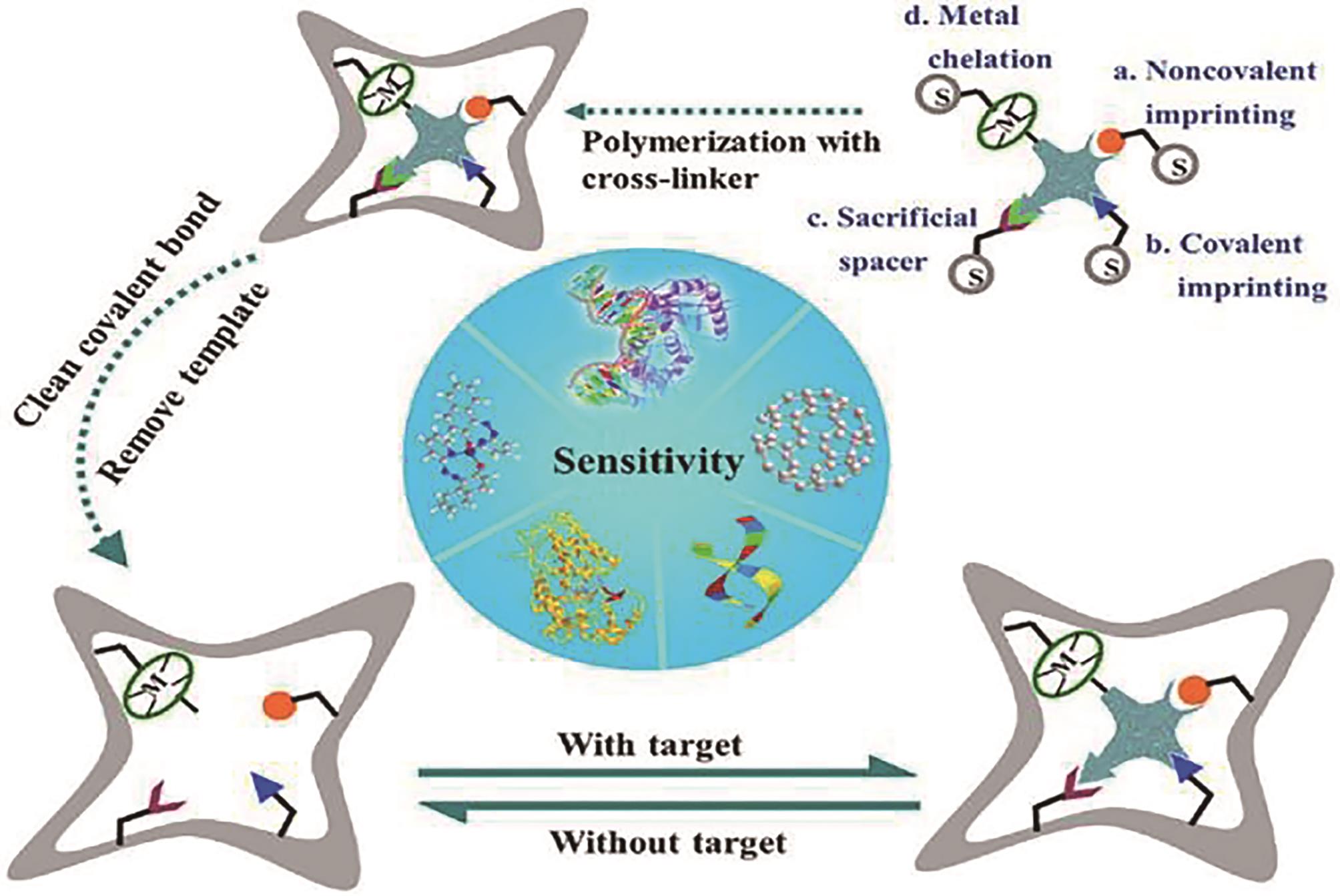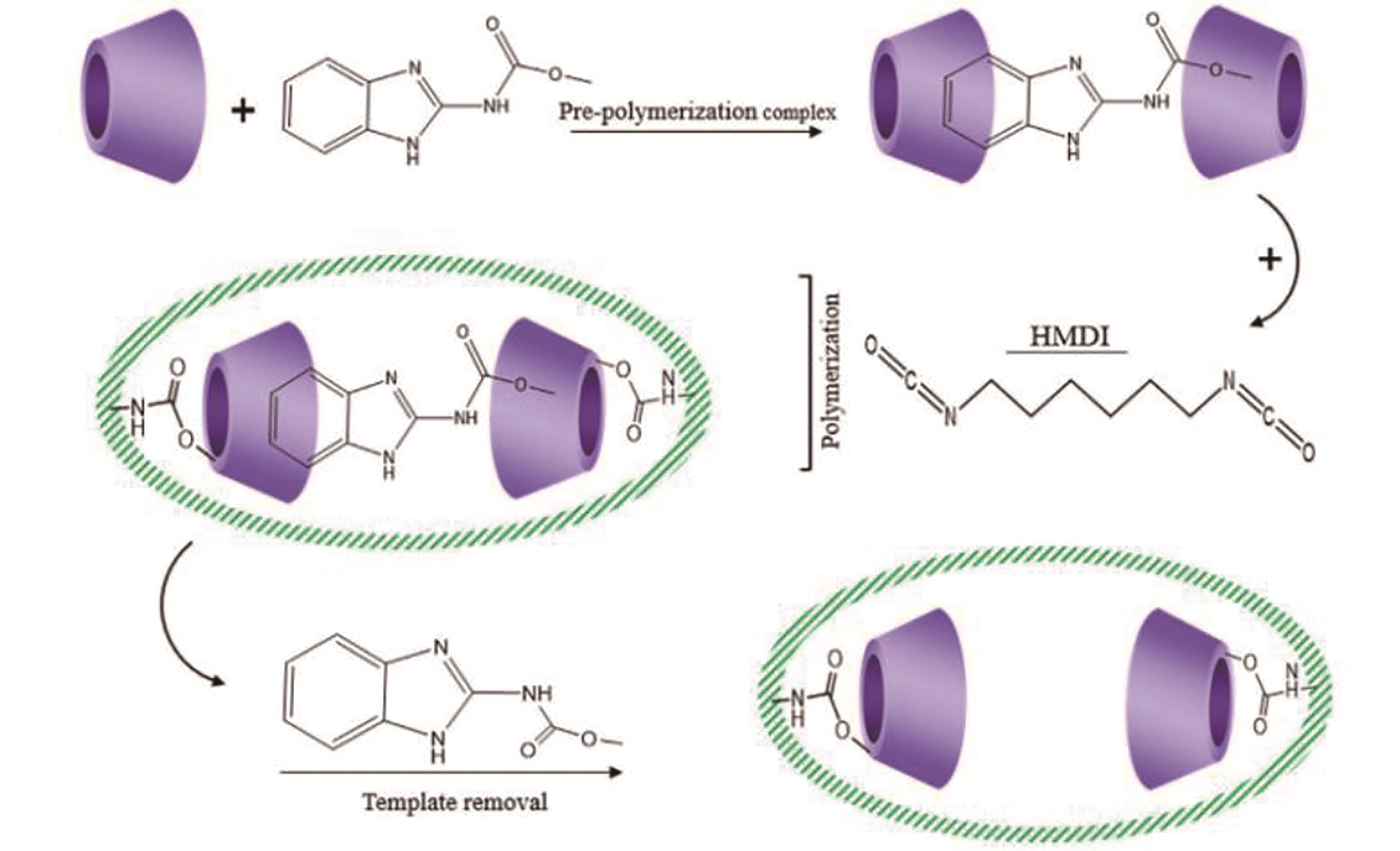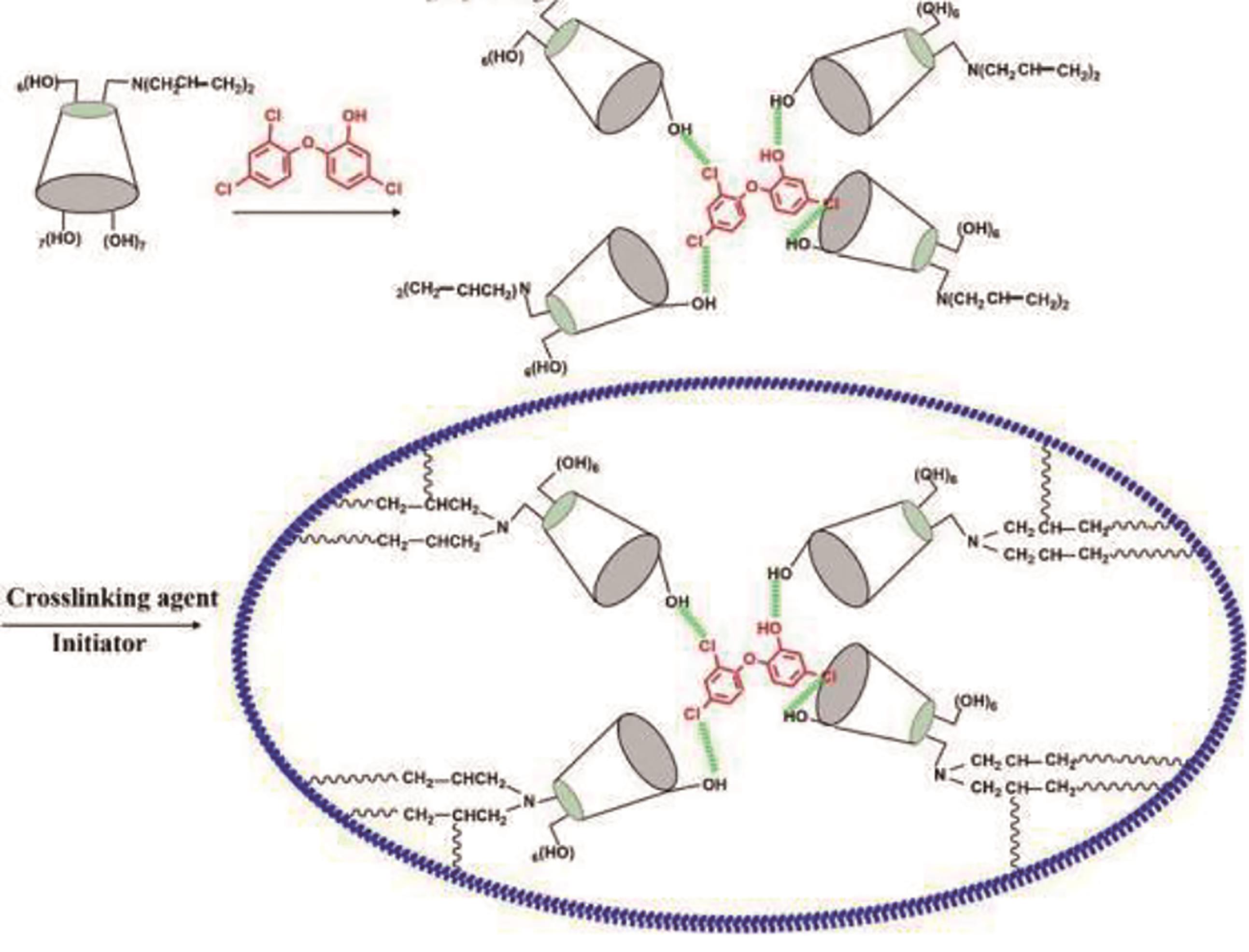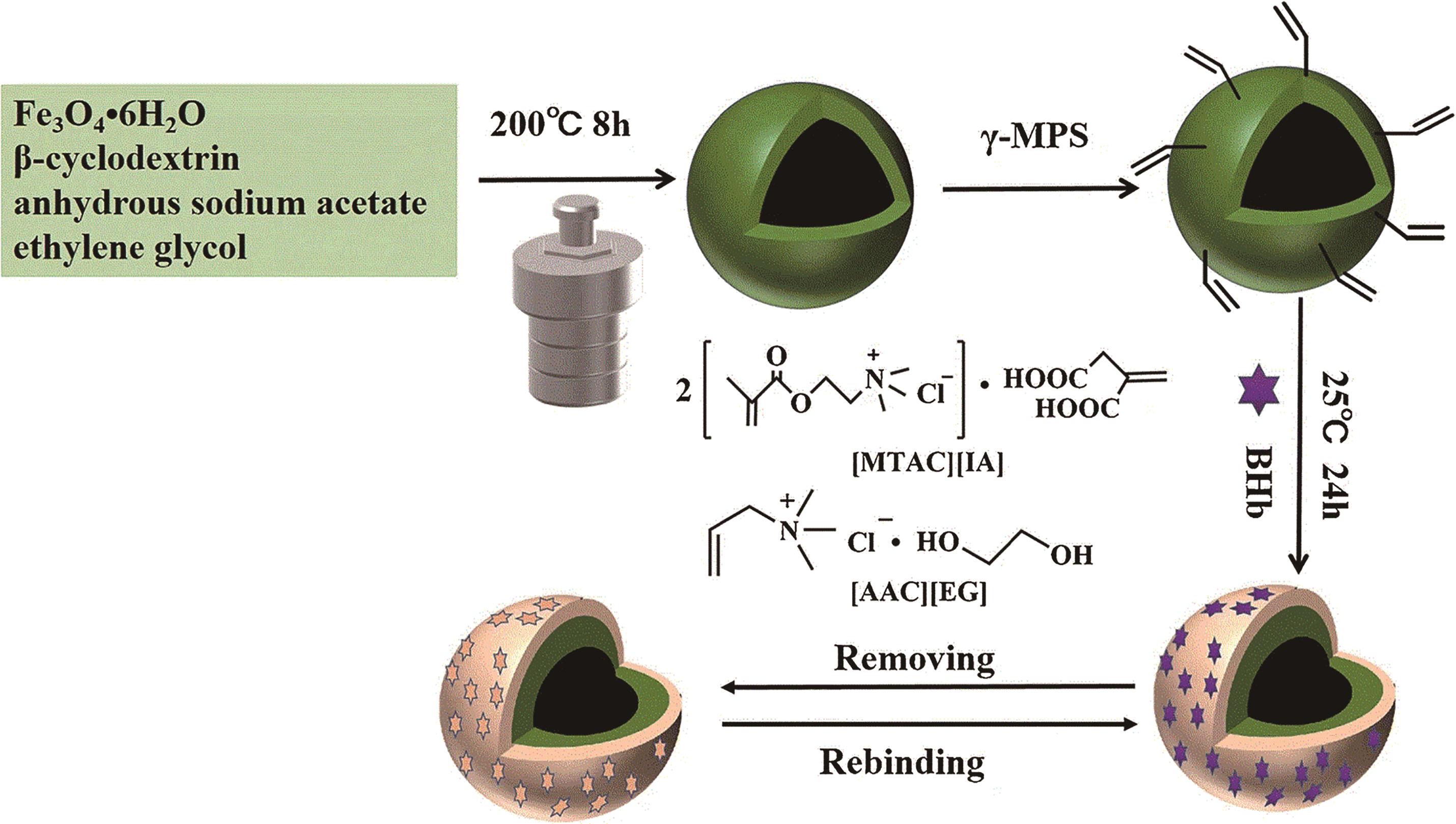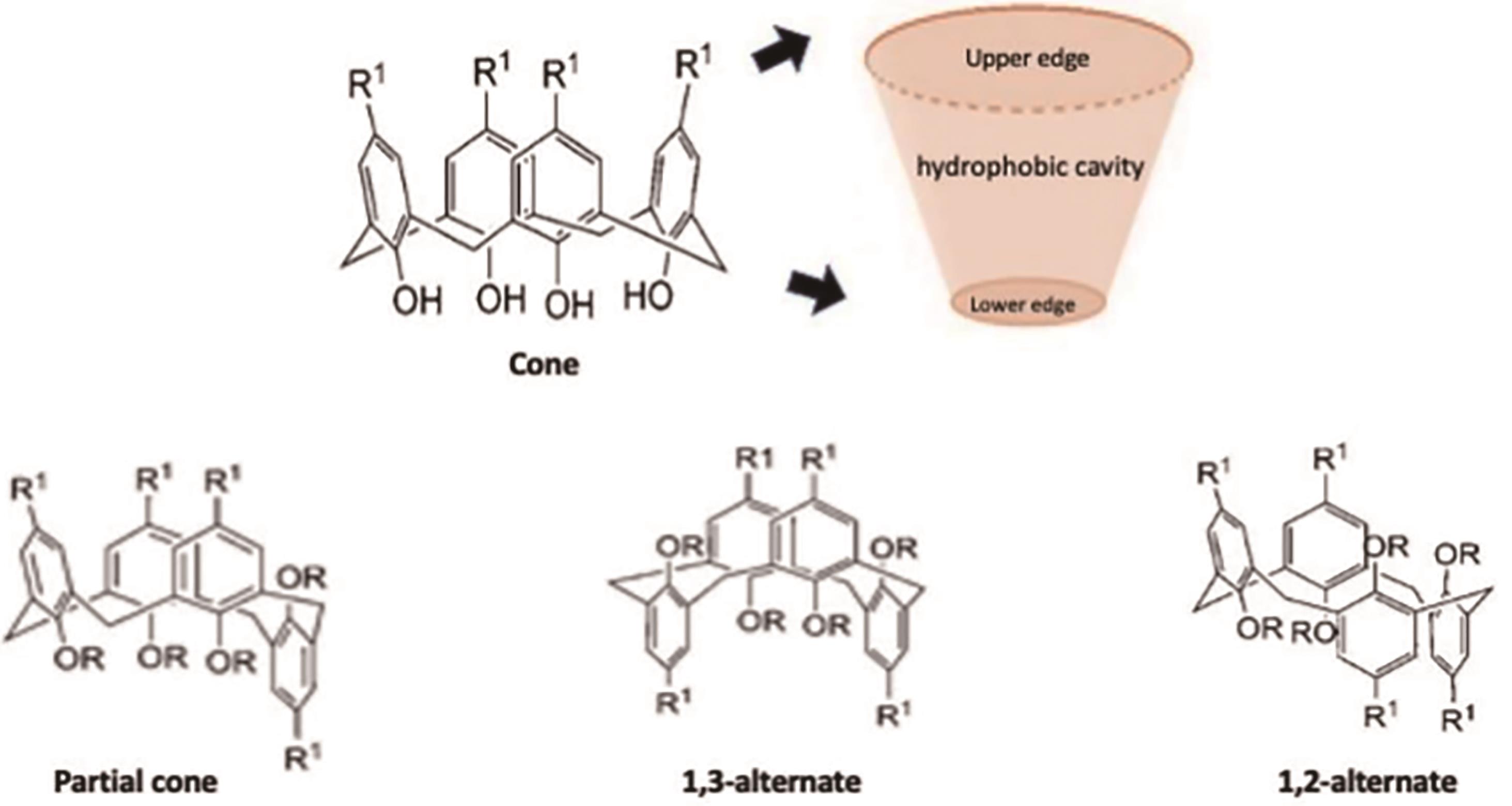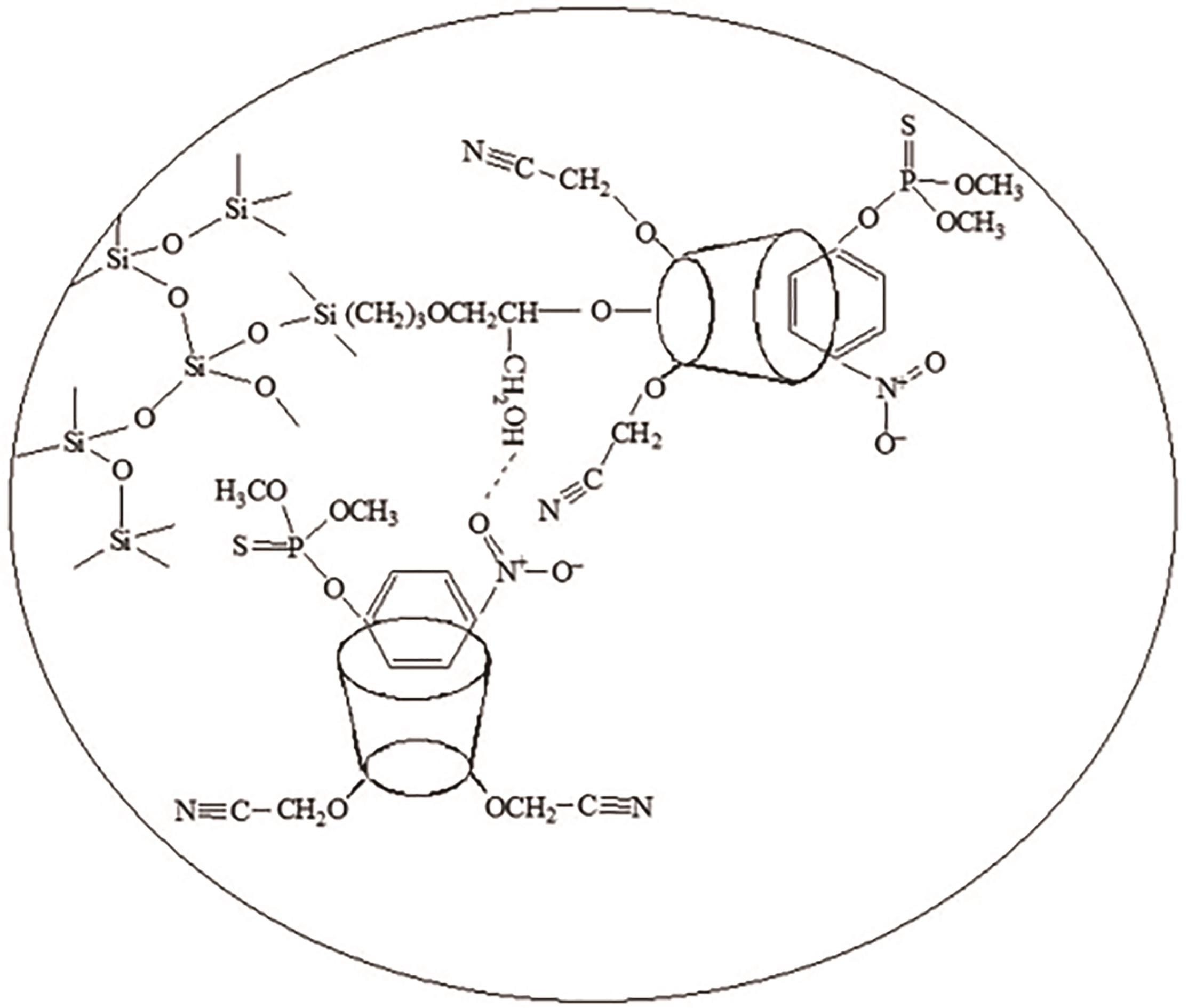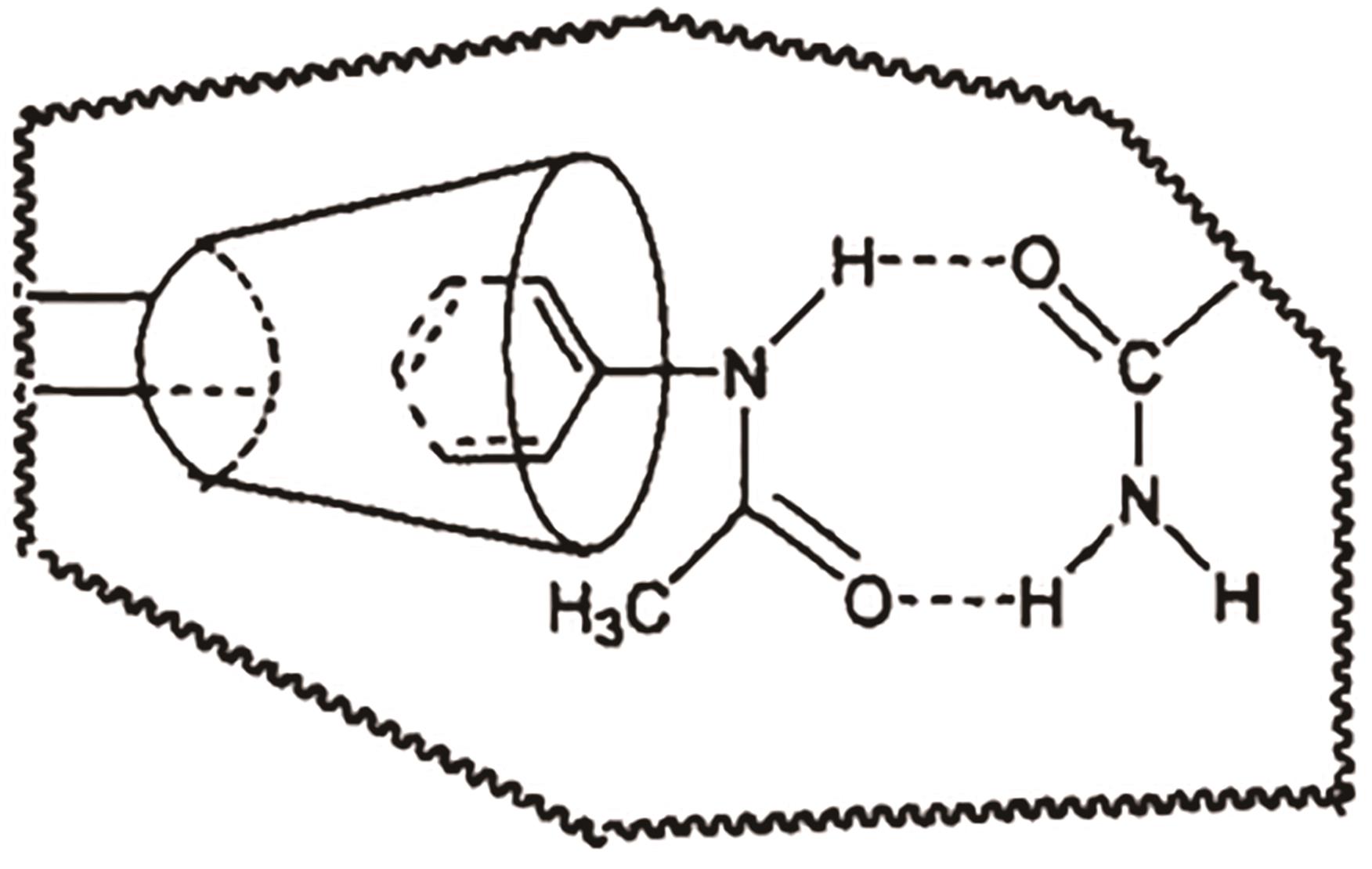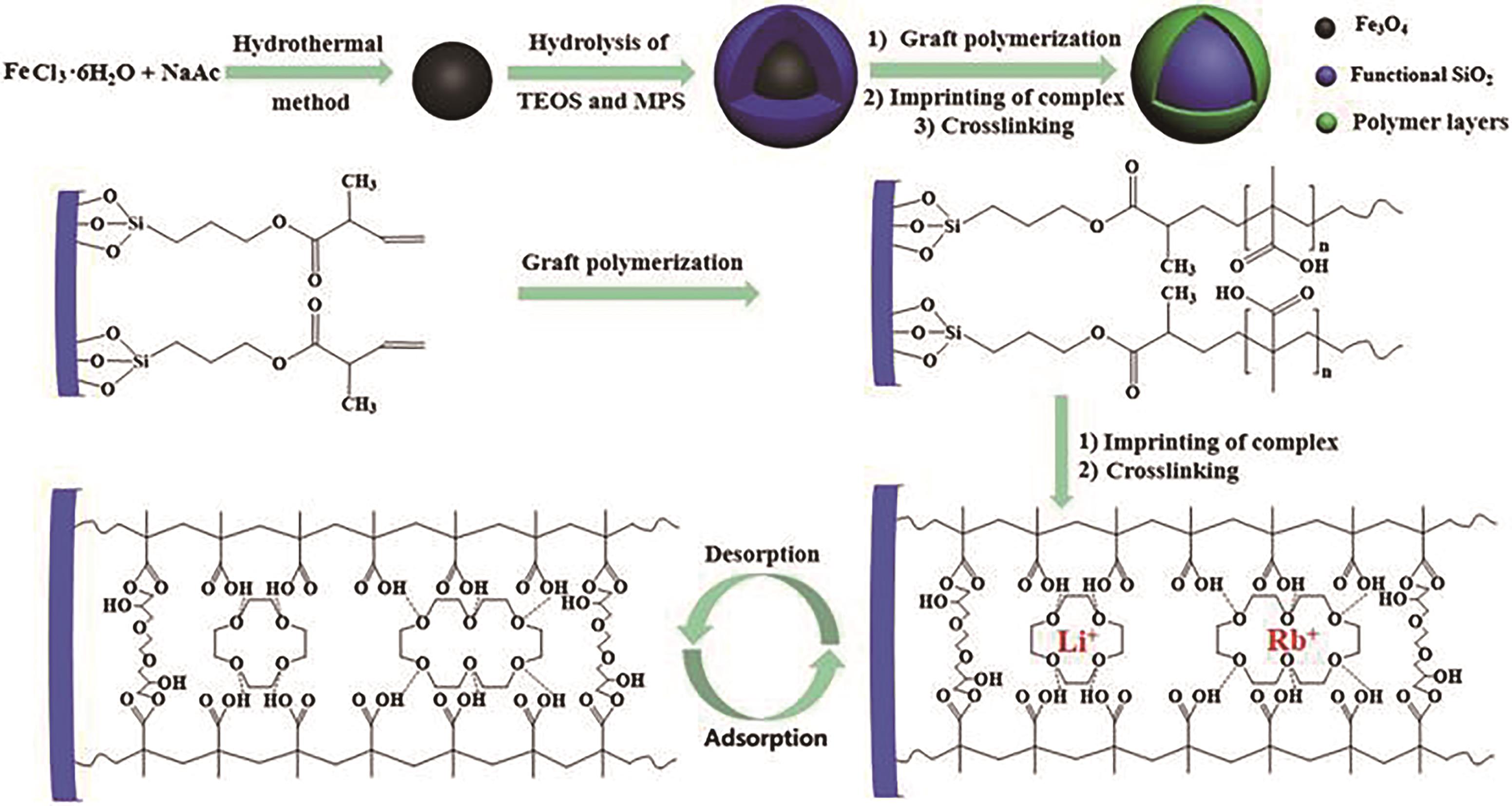
Chinese Journal of Applied Chemistry ›› 2023, Vol. 40 ›› Issue (1): 24-39.DOI: 10.19894/j.issn.1000-0518.220142
• Review • Previous Articles Next Articles
Research Progress of Macrocyclic Compounds in Highly Selective Molecular Imprinting Recognition System
Jing-Xia GAO, Zi-An WANG, Lian-Ming ZHANG( ), Jian-Ping LI
), Jian-Ping LI
- College of Chemistry and Bioengineering,Guilin University of Technology,Guilin 541006,China
-
Received:2022-04-19Accepted:2022-09-14Published:2023-01-01Online:2023-01-28 -
Contact:Lian-Ming ZHANG -
About author:lianming226@126.com
-
Supported by:the Guangxi Science and Technology Project(Guike AD19110059);the Guangxi Postgraduate Education Innovation Project(YCSW2022332)
CLC Number:
Cite this article
Jing-Xia GAO, Zi-An WANG, Lian-Ming ZHANG, Jian-Ping LI. Research Progress of Macrocyclic Compounds in Highly Selective Molecular Imprinting Recognition System[J]. Chinese Journal of Applied Chemistry, 2023, 40(1): 24-39.
share this article
Add to citation manager EndNote|Ris|BibTeX
URL: http://yyhx.ciac.jl.cn/EN/10.19894/j.issn.1000-0518.220142
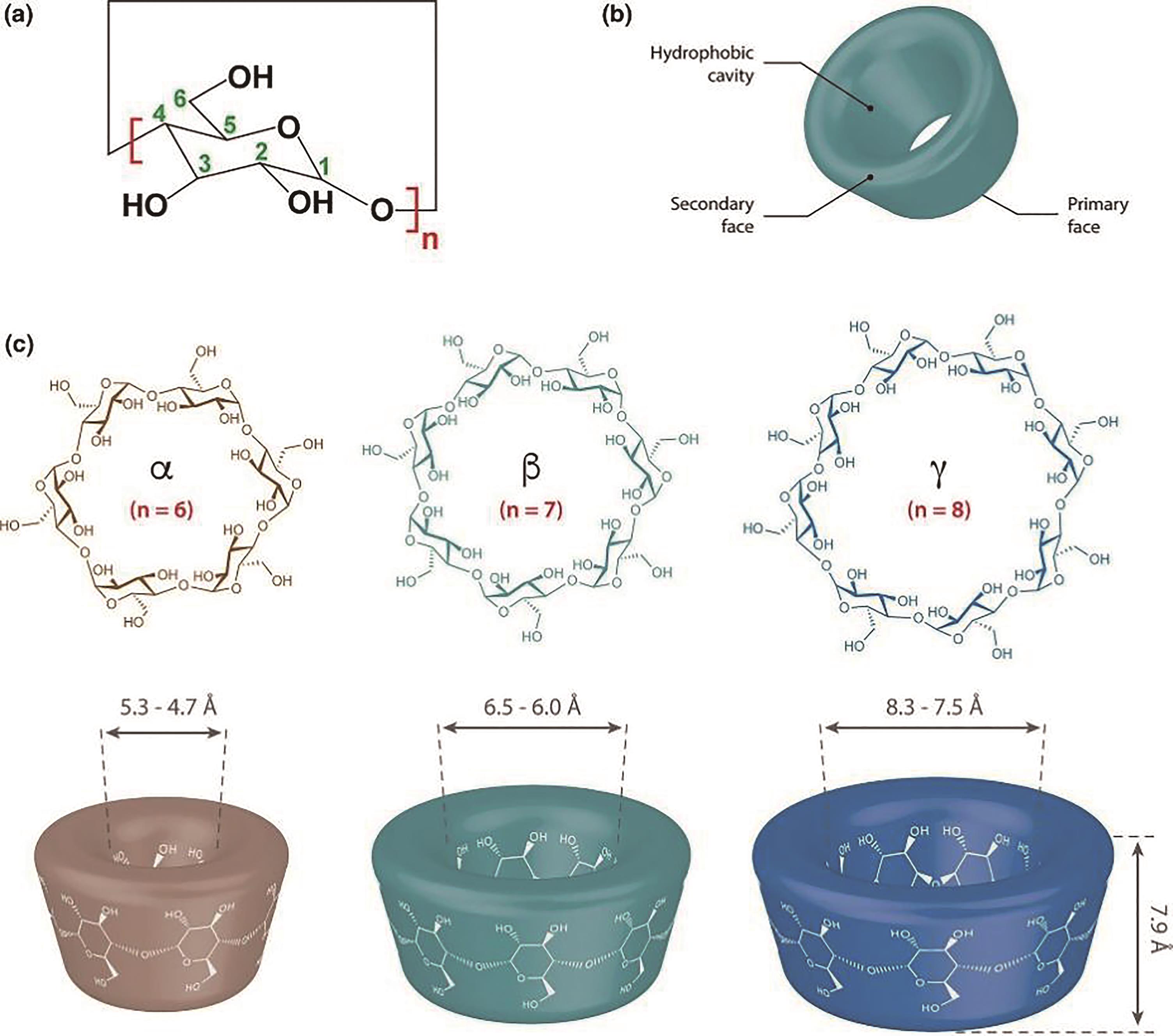
Fig.2 Schematic representations of the general chemical structure(a), the tridimensional structure of CD (b), and chemical structure and dimensions for α-, β- and γ-CD (n=6, 7 and 8, respectively) (c)[50]
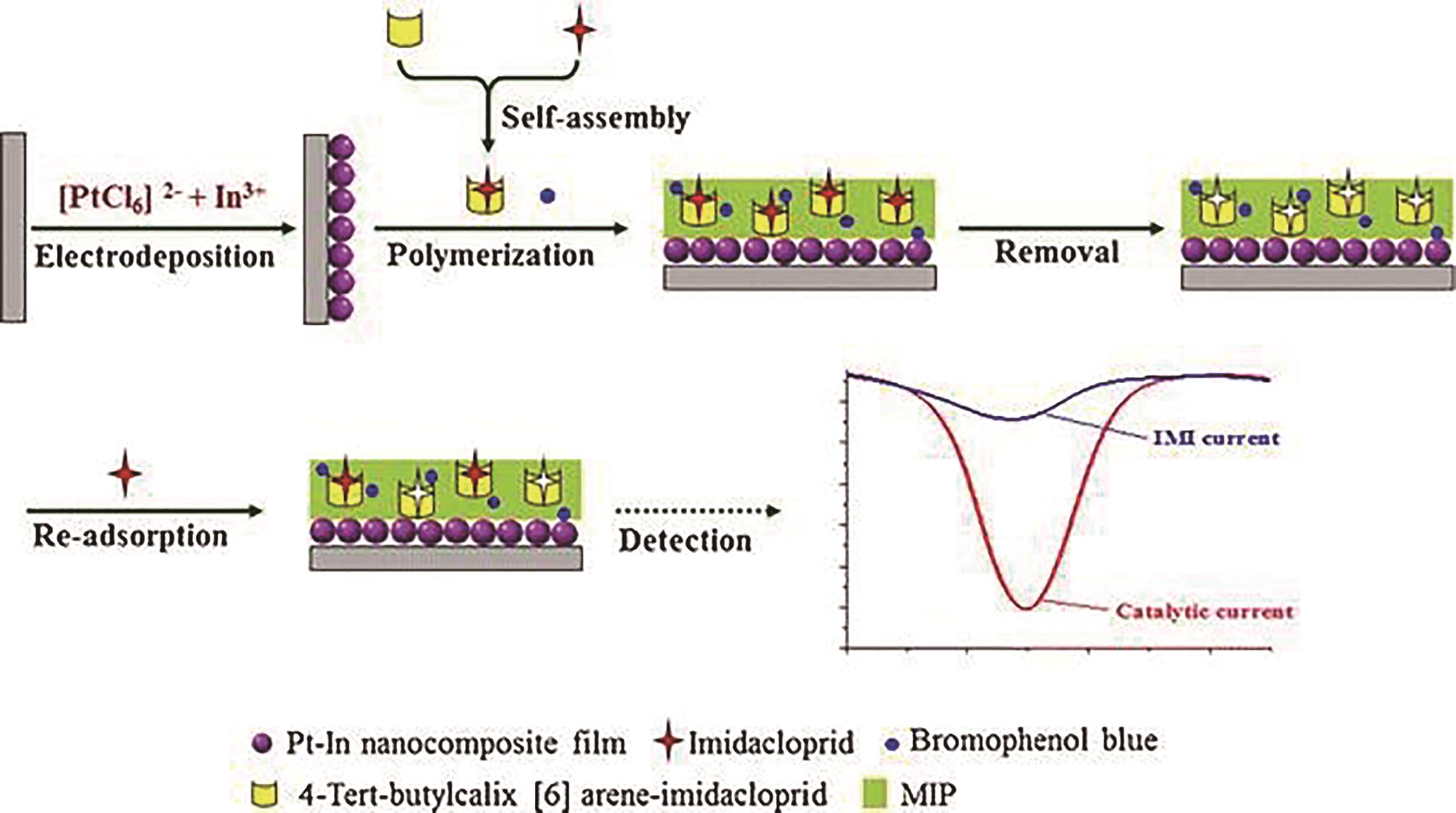
Fig.10 Supramolecular imprinted electrochemical sensor for the neonicotinoid insecticide imidacloprid based on double amplification by Pt-In catalytic nanoparticles and a Bromophenol blue doped molecularly imprinted film[80]
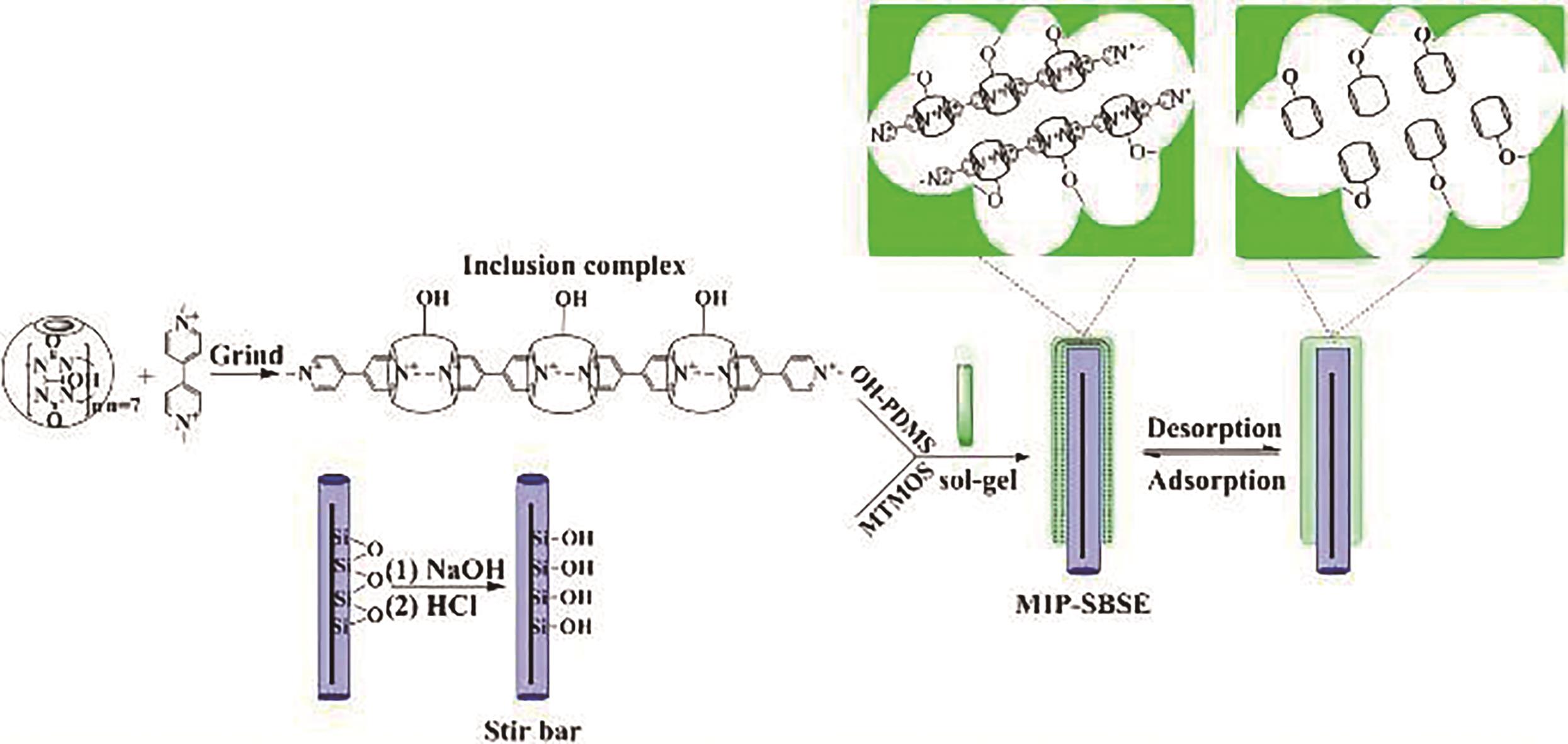
Fig.16 Specific recognition of cationic paraquat in environmental water and vegetable samples by molecularly imprinted stir-bar sorptive extraction based on monohydroxylcucurbit[7]uril-paraquat inclusion complex[96]
| Macrocyclic compounds | Application mode | Reported applications | Deficiency |
|---|---|---|---|
| CD | Functional monomer, carrier | Metal ions, steroid molecules, pesticide residues, porphyrins, amino acids, oligopeptides, proteins, etc. | As anion receptors, CD and its derivatives are not easy to directly coated inorganic anions or positively charged receptors. It is difficult to maintain the activity of oligopeptides, proteins and other biological macromolecules in the elution process[ |
| CA | Functional monomer | Acetanilide, α-tocopherol, L-dopa and other chiral drugs, organic phosphorus pesticides such as methyl parathion and imidacloprid etc. | Because the structure of CA is wide at the top and narrow at the bottom, molecules are easy to fall off in the recognition process, and CA has poor water solubility[ |
| CE | Functional monomer,Assisted recognition unit | K+, Rb+, Li+ and other alkali metal ions. | CE does not bind to anions. Due to the size of ring structure, CE is difficult to be applied to molecular recognition[ |
| CB | Functional monomer | Paraquat, melamine, quaternary ammonium salt and other pesticide molecules | CB has poor solubility and strong structural rigidity, so it cannot change its shape to suit the guest molecules. The separation and purification of CB[n] is very difficult and not easy to be functionalized[ |
| PA | Assisted recognition unit | Methylviologen, 2-naphthoic acid pyrene, etc. | PA molecule has electron-rich cavity, highly symmetrical structure and strong rigidity[ |
Table 1 Application of macrocyclic compounds in MIT
| Macrocyclic compounds | Application mode | Reported applications | Deficiency |
|---|---|---|---|
| CD | Functional monomer, carrier | Metal ions, steroid molecules, pesticide residues, porphyrins, amino acids, oligopeptides, proteins, etc. | As anion receptors, CD and its derivatives are not easy to directly coated inorganic anions or positively charged receptors. It is difficult to maintain the activity of oligopeptides, proteins and other biological macromolecules in the elution process[ |
| CA | Functional monomer | Acetanilide, α-tocopherol, L-dopa and other chiral drugs, organic phosphorus pesticides such as methyl parathion and imidacloprid etc. | Because the structure of CA is wide at the top and narrow at the bottom, molecules are easy to fall off in the recognition process, and CA has poor water solubility[ |
| CE | Functional monomer,Assisted recognition unit | K+, Rb+, Li+ and other alkali metal ions. | CE does not bind to anions. Due to the size of ring structure, CE is difficult to be applied to molecular recognition[ |
| CB | Functional monomer | Paraquat, melamine, quaternary ammonium salt and other pesticide molecules | CB has poor solubility and strong structural rigidity, so it cannot change its shape to suit the guest molecules. The separation and purification of CB[n] is very difficult and not easy to be functionalized[ |
| PA | Assisted recognition unit | Methylviologen, 2-naphthoic acid pyrene, etc. | PA molecule has electron-rich cavity, highly symmetrical structure and strong rigidity[ |
| 1 | WULFF G, SARHAN A. The use of polymers with enzyme-analogous structures for the resolution of racemates[J]. Angew Chem Int Ed, 1972, 11: 341-346. |
| 2 | VlATAKIS G, ANDERSSON L I, MVLLERR R, et al. Drug assay using antibody mimics made by molecular imprinting[J]. Nature, 1993, 361(6413): 645-647. |
| 3 | ERDOSSY J, HORVATH V, YARMAN A, et al. Electrosynthesized molecularly imprinted polymers for protein recognition[J]. TrAC, Trends Anal Chem, 2016, 79: 179-190. |
| 4 | XU J J, MEDINA-RANGLE P X, HAUPT K, et al. Guide to the preparation of molecularly imprinted polymer nanoparticles for protein recognition by solid-phase synthesis[J]. Methods Enzymol, 2017, 590: 115-141. |
| 5 | LI W, ZHANG Q, WANG Y, et al. Controllably prepared aptamer-molecularly imprinted polymer hybrid for high-specificity and high-affinity recognition of target proteins[J]. Anal Chem, 2019, 91(7): 4831-4837. |
| 6 | MIER A, MAFFUCCI I, MERLIER F, et al. Molecularly imprinted polymer nanogelsforprotein recognition: direct proof of specific binding sites by solution STD and water LOGSY NMR spectroscopies[J]. Angew Chem Int Ed, 2021, 60(38): 20849-20857. |
| 7 | ZHAO C, LU W Z, MENG X Y. Using chiral magnetic surface molecularly imprinted polymers for chiral separation of Ofloxacin[J]. J Polym Res, 2021, 28(6): 1-8. |
| 8 | DERAZSHAMSHIR A, GOKTURK I, YILMAZ F, et al. S-citalopram imprinted monolithic columns for capillary electrochromatography enantioseparations[J]. Electrophoresis, 2021, 42(24): 2672-2682. |
| 9 | ALHAWITIl A S, MONIER M, ELSAYED N H. Designing of amino functionalized imprinted polymeric resin for enantio-separation of (±)-mandelic acid racemate[J]. React Funct Polym, 2021, 160: 104828. |
| 10 | LOU X Y, SONG N, YANG Y W. Fluorescence resonance energy transfer systems in supramolecular macrocyclic chemistry[J]. Molecules, 2017, 22(10): 1640. |
| 11 | ZHANG L M, LUO K, LI D, et al. Chiral molecular imprinted sensor for highly selective determination of D-carnitine in enantiomers via dsDNA-assisted conformation immobilization[J]. Anal Chim Acta, 2020, 1136:82 -90. |
| 12 | LIU J, ZHANG Y, JIANG M, et al. Electrochemical microfluidic chip based on molecular imprinting technique applied for therapeutic drug monitoring[J]. Biosens Bioelectron, 2017, 91: 714-720. |
| 13 | ANSARI S, KARIMI M. Novel developments and trends of analytical methods for drug analysis in biological and environmental samples by molecularly imprinted polymers[J]. TrAC, Trends Anal Chem, 2017, 89: 146-162. |
| 14 | LIN F, TIAN Y S, LOU D D, et al. Catalytic gold-platinum alloy nanoparticles and a novel glucose oxidase mimic with enhanced activity and selectivity constructed by molecular imprinting[J]. Anal Methods, 2019, 11(36): 4586-4592. |
| 15 | LI J P, ZHANG L M, FU C. The recognizing mechanism and selectivity of the molecularly imprinting membrane[J]. Mol Imprinted Catal, 2016: 159-182. |
| 16 | CHEN T, WEI S, CHENG Z F, et al. Specific detection of monosaccharide by dual-channel sensing platform based on dual catalytic system constructed by bio-enzyme and bionic enzyme using molecular imprinting polymers[J]. Sens Actuators B: Chem, 2020, 320: 128430. |
| 17 | ZHANG L M, ZHANG D Y, YING Z, et al. A cimaterol molecularly imprinted sensor based on DNA-assisted recognition[J]. Chin J Anal Chem, 2018, 46(11): 1770-1777. |
| 18 | TARANNUM N, HENDRICKSON O D, KHATOON S, et al. Molecularly imprinted polymers as receptors for assays of antibiotics[J]. Crit Rev Anal Chem, 2020, 50(4): 291-310. |
| 19 | WANG M C, WANG Y, QIAO Y, et al. High-sensitive imprinted membranes based on surface-enhanced Raman scattering for selective detection of antibiotics in water[J]. Spectrochim Acta,Part A, 2019, 222: 117116. |
| 20 | LI J P, LI Y P, ZHANG Y, et al. Highly sensitive molecularly imprinted electrochemical sensor based on the double amplification by an inorganic prussian blue catalytic polymer and the enzymatic effect of glucose oxidase[J]. Anal Chem, 2012, 84(4): 1888-1893. |
| 21 | LEHN J M. Supramolecular chemistry-scope and perspectives molecules, supermolecules, and molecular devices (Nobel Lecture)[J]. Angew Chem Int Ed, 1988, 27(1): 89-112. |
| 22 | PAUL R, PAUL S. Synergistic host-guest hydrophobic and hydrogen bonding interactions in the complexation between endo-functionalized molecular tube and strongly hydrophilic guest molecules in aqueous solution[J]. Phys Chem Chem Phys, 2018, 20(24): 16540-16550. |
| 23 | ZHOU Y, JIE K, ZHAO R, et al. Supramolecular-macrocycle-based crystalline organic materials[J]. Adv Mater, 2020, 32(20): 1904824. |
| 24 | DONG S Y, GAO L Y, CHEN J Z, et al. A supramolecular polymer formed by the combination of crown ether-based and charge-transfer molecular recognition[J]. Polym Chem, 2013, 4(4): 882-886. |
| 25 | GE Z S, H J M, HUANG F H, et al. Responsive supramolecular gels constructed by crown ether based molecular recognition[J]. Chem Soc Rev, 2005, 34: 821-836. |
| 26 | HARADA A, TAKASHIMA Y, NAKAHATA M. Supramolecular polymeric materials via cyclodextrin-guest interactions[J]. Acc Chem Res, 2014, 47(7): 2128-2140. |
| 27 | ZHANG Y M, XU Q Y, LIU Y. Molecular recognition and biological application of modified β-cyclodextrins[J]. China Chem, 2019, 62: 549-560. |
| 28 | NAKAHATA M, TAKASHIMA Y, HARADA A. Supramolecular polymeric materials containing cyclodextrins[J]. Chem Pharm Bull, 2017, 65(4): 330-335. |
| 29 | 吉晓帆, 夏丹玉, 颜徐州, 等. 基于冠醚和柱芳烃主客体识别的超分子聚合物材料[J]. 高分子学报, 2017(1): 9-17. |
| JI X F, XIA D Y, YAN X Z, et al. Supramolecular polymer materials based on host-guest recognition of crown ethers and pillar arenes[J]. Acta Polym Sin, 2017(1): 9-17. | |
| 30 | BARROW S J, KASERA S, ROWLAND M J, et al. Cucurbituril-based molecular recognition[J]. Chem Rev, 2015, 115(22): 12320-12406. |
| 31 | LI P Y, CHEN Y, LIU Y. Calixarene/pillararene-based supramolecular selective binding and molecular assembly[J]. Lett, 2019, 30(6): 1190-1197. |
| 32 | LIU Z, DAI X Y, SUN Y H, et al. Organic supramolecular aggregates based on water-soluble cyclodextrins and calixarenes[J]. Aggregate, 2020, 1(1): 31-44. |
| 33 | YOU L, ZHA D, ANSLYN E V. Recent advances in supramolecular analytical chemistry using optical sensing[J]. Chem Rev, 2015, 115(15): 7840-7892. |
| 34 | CICOLANI R S, SOUZA L R R, DE SANTANA DIAS G B, et al. Cucurbiturils for environmental and analytical chemistry[J]. J Inclusion Phenom Macrocyclic Chem, 2021, 99(1): 1-12. |
| 35 | ZHOU J, LI J, DU X W, et al. Supramolecular biofunctional materials[J]. Biomaterials, 2017, 129: 1-27. |
| 36 | WANG L, CHENG L, LI G, et al. A self-cross-linking supramolecular polymer network enabled by crown-ether-based molecular recognition[J]. J Am Chem Soc, 2020, 142(4): 2051-2058. |
| 37 | DONG S Y, ZHENG B, WANG F, et al. Supramolecular polymers constructed from macrocycle-based host-guest molecular recognition motifs[J]. Acc Chem Res, 2014, 47(7): 1982-1994. |
| 38 | GUS’KOV V Y, MAISTRENKO V. New chiral stationary phases: preparation, properties, and applications in gas chromatography[J]. J Anal Chem, 2018, 73(10): 937-945. |
| 39 | SUN T, LI B, SHUAI X, et al. Performance and selectivity of lower-rim substituted calix[4]arene as a stationary phase for capillary gas chromatography[J]. RSC Adv, 2019, 9(37): 21207-21214. |
| 40 | GAI Y Y, LIANG S, CHEN W, et al. Practical evaluation of chitosan-based chiral stationary phase for pharmaceutical analysis by high-performance liquid chromatography[J]. Chromatographia, 2022, 85: 247-254. |
| 41 | CHEN W, JIANG J Z, QIU G S, et al. The interactions between chiral analytes and chitosan-based chiral stationary phases during enantioseparation[J]. J Chromatogr A, 2021, 1650: 462259. |
| 42 | SUN Y, LI C, NIU X Y, et al. Rapid and mild fabrication of protein membrane coated capillary based on supramolecular assemble for chiral separation in capillary electrochromatography[J]. Talanta, 2019, 195: 190-196. |
| 43 | LAY S, NI X F, YU H N et al. State-of-the-art applications of cyclodextrins as functional monomers in molecular imprinting techniques: a review[J]. J Sep Sci, 2016, 39(12): 2321-2331. |
| 44 | LIANG X, LIANG W, JIN P, et al. Advances in chirality sensing with macrocyclic molecules[J]. Chemosensors, 2021, 9(10): 279. |
| 45 | LI J P, WEI G, ZHANG Y. Molecularly imprinted polymers as recognition elements in sensors[J]. Mol Imprinted Sens, 2012: 35-55. |
| 46 | YANG B, FU C, LI J P, et al. Frontiers in highly sensitive molecularly imprinted electrochemical sensors: challenges and strategies[J]. Trends Anal Chem, 2018, 105: 52-67. |
| 47 | LI S H, LI J P, MA X H, et al. Highly selective molecular imprinting electrochemiluminescence switch sensor for biotoxin L-canavanine measurement[J]. Microchem J, 2019, 148: 397-403. |
| 48 | LI D, LUO K, ZHANG L M, et al. Research and application of highly selective molecular imprinting technology in chiral separation analysis[J]. Crit Rev Anal Chem, 2021: 1-14. |
| 49 | WANG Y, SUN Y W, BIAN H, et al. Cyclodextrin porous liquid materials for efficient chiral recognition and separation of nucleosides[J]. ACS Appl Mater Interfaces, 2020, 12(41): 45916-45928. |
| 50 | CRINI G, FOURMENTIN S, FENVVESI É, et al. Cyclodextrins, from molecules to applications[J]. Environ Chem Lett, 2018, 16(4): 1361-1375. |
| 51 | SREENIVASAN K. Synthesis and evaluation of a beta cyclodextrin-based molecularly imprinted copolymer[J]. J Appl Polym Sci, 1998, 70(1): 15-18. |
| 52 | ZHAO X Y, WANG Y, ZHANG P, et al. Recent advances of molecularly imprinted polymers based on cyclodextrin[J]. Macromol Rapid Commun, 2021, 42(9): 2100004. |
| 53 | LIU Y C, LIU Y J, LIU Z M, et al. Supramolecularly imprinted polymeric solid phase microextraction coatings for synergetic recognition nitrophenols and bisphenol A[J]. J Hazard Mater, 2019, 368: 358-364. |
| 54 | HUANG D L, TANG Z H, PENG Z W, et al. Fabrication of water-compatible molecularly imprinted polymer based on β-cyclodextrin modified magnetic chitosan and its application for selective removal of bisphenol A from aqueous solution[J]. J Taiwan Inst Chem Eng, 2017, 77: 113-121. |
| 55 | FAROOQ S, NIE J Y, CHENG Y, et al. Selective extraction of fungicide carbendazim in fruits using β-cyclodextrin based molecularly imprinted polymers[J]. J Sep Sci, 2020, 43(6): 1145-1153. |
| 56 | XU Z F, WEN G, KUANG D Z, et al. Selective separation of deltamethrin by molecularly imprinted polymers using a β-cyclodextrin derivative as the functional monomer[J]. J Environmental Sci Health, Part B, 2013, 48(5): 336-343. |
| 57 | ZHAO L, WANG X L, MA L, et al. Improving affinity of β-cyclodextrin-based molecularly imprinted polymer using room temperature ionic liquid[J]. Eur Polym J, 2019, 116: 275-282. |
| 58 | LIU Y C, LIU Y J, LIU Z M, et al. β-Cyclodextrin molecularly imprinted solid-phase microextraction coatings for selective recognition of polychlorophenols in water samples[J]. Anal Bioanal Chem, 2018, 410(2): 509-519. |
| 59 | DOLAI J, ALI H, JANA N R. Molecular imprinted poly-cyclodextrin for selective removal of dibutyl phthalate[J]. ACS Appl Polym Mater, 2019, 2(2): 691-698. |
| 60 | WANG C, DING C, WU Q, et al. Molecularly imprinted polymers with dual template and bifunctional monomers for selective and simultaneous solid-phase extraction and gas chromatographic determination of four plant growth regulators in plant-derived tissues and foods[J]. Food Anal Methods, 2019, 12(5): 1160-1169. |
| 61 | ZHANG L, HE L, WANG Q, et al. Theoretical and experimental studies of a novel electrochemical sensor based on molecularly imprinted polymer and GQDs-PtNPs nanocomposite[J]. Microchem J, 2020, 158: 105196. |
| 62 | GUO H Q, XIONG J J, MA W T, et al. Synthesis of molecularly imprinted polymers using acrylamide-beta-cyclodextrin as a cofunctional monomer for the specific capture of tea saponins from the defatted cake extract of Camellia oleifera[J]. J Sep Sci, 2016, 39(22): 4439-4448. |
| 63 | LAY S, YU H N, HU B X, et al. Molecularly imprinted polymers as the extracted sorbents of clenbuterol ahead of liquid chromatographic determination[J]. Zhejiang Univ Sci, 2016, 17(6): 465-475. |
| 64 | ZHANG X, ZHANG N, DU C, et al. Preparation of magnetic epitope imprinted polymer microspheres using cyclodextrin-based ionic liquids as functional monomer for highly selective and effective enrichment of cytochrome c[J]. Chem Eng J, 2017, 317: 988-998. |
| 65 | ZHANG P, CHEN G, WANG Z, et al. Design and synthesis of Fe3O4@Au@cyclodextrin-molecularly imprinted polymers labeled with SERS nanotags for ultrasensitive detection of transferrin[J]. Sens Actuators B: Chem, 2022, 361: 131669. |
| 66 | 刘彩萍, 白阳. 环糊精超分子聚合物在药物/基因递送载体领域的研究进展[J]. 化学通报, 2018, 81(4): 326-331, 383. |
| LIU C P, BAI Y. Research progress of cyclodextrinsupramolecular polymers in the field of drug/gene delivery vehicles[J]. Chem Bull, 2018, 81(4): 326-331, 383. | |
| 67 | 张芸, 郭敏杰, 么敬霞, 等. 以环糊精准聚轮烷为 “假载体” 印迹识别蛋白质的研究[J]. 分析化学, 2014, 42(2): 186-191. |
| ZHANG Y, GUO M J, ME J X et al. Research on protein recognition by imprinting using cyclodextrin precise polyrotaxane as “pseudocarrier”[J]. Chin J Anal Chem, 2014, 42(2): 186-191. | |
| 68 | 代国飞, 王明伟. 环糊精及其衍生物的药学应用进展[J]. 中国新药杂志, 2005, 14(11): 1261-1264. |
| DAI G F, WANG M W. Advances in pharmaceutical application of cyclodextrin and its derivatives[J]. Chin J New Drug, 2005, 14(11): 1261-1264. | |
| 69 | HE X Y, WANG Y Z, LI H, et al. Specific recognition of protein by deep eutectic solvent-based magnetic β-cyclodextrin molecularly imprinted polymer[J]. Microchim Acta, 2021, 188(7): 1-9. |
| 70 | TROTTA F, CALDRA F, CAVALLI R, et al. Molecularly imprinted cyclodextrinnanosponges for the controlled delivery of L-DOPA: perspectives for the treatment of Parkinson's disease[J]. Expert Opin Drug Delivery, 2016, 13(12): 1671-1680. |
| 71 | JURIC D, ROHNER N A, VON RECUM H A. Molecular imprinting of cyclodextrinsupramolecular hydrogels improves drug loading and delivery[J]. Macromol Biosci, 2019, 19(1): 1800246. |
| 72 | BASILOTTA R, MANNINO D, FILIPPONE A, et al. Role of calixarene in chemotherapy delivery strategies[J]. Molecules, 2021, 26(13): 3963. |
| 73 | CHEN C F, HAN Y. Triptycene-derived macrocyclicarenes: from calixarenes to helicarenes[J]. Acc Chem Res, 2018, 51(9): 2093-2106. |
| 74 | 曹丙庆, 潘勇, 赵建军, 等. 对-叔丁基杯[4]芳烃衍生物自组装分子在声表面波传感器中检测有机磷[J]. 应用化学, 2008, 25(10): 1176-118 |
| CAO B Q, PAN Y, ZHAO J J, et al. Detection of organophosphorus compounds by surface acoustic wave sensor with p-tertbutylcalix[4]arene self-assembly coatings[J]. Chin J Appl Chem, 2008, 25(10): 1176-1180. | |
| 75 | YANG B J, CAO X J. Synthesis of the artemisinin-imprinting polymers on silica surface and its adsorption behavior in supercritical CO2 fluid[J]. AIChE J, 2011, 57(12): 3514-3521. |
| 76 | YILMAZ M, ERDEMIR S. Calixarene-based receptors for molecular recognition[J]. Turk J Chem, 2013, 37(4): 558-585. |
| 77 | LI C Y, WANG C F, GUAN B, et al. Electrochemical sensor for the determination of parathion based on p-tert-butylcalix[6]arene-1,4-crown-4 sol-gel film and its characterization by electrochemical methods[J]. Sens Actuators B: Chem, 2005, 107(1): 411-417. |
| 78 | 潘勇, 何世堂, 林涛, 等. 间苯二酚杯[4]芳烃硫醚衍生物SAW分子印迹膜的合成[J]. 化学传感器, 2010, 30(3): 48-53. |
| PAN Y, HE S T, LIN T, et al. Synthesis of SAW molecularly imprinted membrane of resorcinol calix[4]arenethioether derivatives[J]. Chem Sens, 2010, 30(3): 48-53. | |
| 79 | LI J W, WANG Y L, YAN S, et al. Molecularly imprinted calixarene fiber for solid-phase microextraction of four organophosphorous pesticides in fruits [J]. Food Chem, 2016, 192: 260-267. |
| 80 | LI S, LIU C, YIN G. et al. Supramolecular imprinted electrochemical sensor for the neonicotinoid insecticide imidacloprid based on double amplification by Pt-In catalytic nanoparticles and a Bromophenol blue doped molecularly imprinted film[J]. Microchim Acta, 2016, 183: 3101-3109. |
| 81 | LU C Y, HE H C, HE X W, et al. Molecularly imprinted polymer with calix[4]arene derivative for the recognition of acetanilide[J]. Chin J Chem, 2004, 22(3): 275-278. |
| 82 | NICOI F, BARONCINI M, SILVI S, et al. Direct synthetic routes to functionalised crown ethers[J]. Org Chem Front, 2021, 8(19): 5531-5549. |
| 83 | LUO H, CHEN L X, GE Q M, et al. Applications of macrocyclic compounds for electrochemical sensors to improve selectivity and sensitivity[J]. J Inclusion Phenom Macrocyclic Chem, 2019, 95(3): 171-198. |
| 84 | ANDERSSON H S, RAMSTROM O. Crown ethers as a tool for the preparation of molecularly imprinted polymers[J]. J Mol Recognit: An Interdisciplinary J, 1998, 11(1/6): 103-106. |
| 85 | RAJABI H R, SHAMSIPUR M, POURMORTAZAVI S M. Preparation of a novel potassium ion imprinted polymeric nanoparticles based on dicyclohexyl 18C6 for selective determination of K+ ion in different water samples[J]. Mater Sci Eng C, 2013, 33(6): 3374-3381. |
| 86 | LUO X B, LIU L L, DENG F, et al. Novel ion-imprinted polymer using crown ether as a functional monomer for selective removal of Pb(II) ions in real environmental water samples[J]. J Mater Chem A, 2013, 1(28): 8280-8286. |
| 87 | XU J C, PU Z L, XU X C, et al. Simultaneous adsorption of Li(I) and Rb(I) by dual crown ethers modified magnetic ion imprinting polymers[J]. Appl Organomet Chem, 2019, 33(3): e4778. |
| 88 | ZHOU Z Y, HU Y L, WANG Z, et al. Facile preparation of a rubidium ion-imprinted polymer by bulk polymerization for highly efficient separation of rubidium ions from aqueous solution[J]. New J Chem, 2021, 45(21): 9582-9590. |
| 89 | LIANG Q, ZHANG E H, YAN G, et al. A lithium ion-imprinted adsorbent using magnetic carbon nanospheres as a support for the selective recovery of lithium ions[J]. New Carbon Mater, 2020, 35(6): 696-706. |
| 90 | JIANG C Y, FANG M, HUANG A, et al. Fabrication of novel magnetic rubidium ion-imprinted polymer for the selective separation[J]. New J Chem, 2022: 46: 6343-6352 |
| 91 | SHAO H, LI C, MA C, et al. An ion-imprinted material embedded carbon quantum dots for selective fluorometric determination of lithium ion in water samples[J]. Microchim Acta, 2017, 184(12): 4861-4868. |
| 92 | LIU W F, YAN G, ZHANG E, et al. Extraction of lithium ions from acidic solution using electrochemically imprinted membrane[J]. Desalination, 2020, 496: 114751. |
| 93 | LEE J W, SAMAL S, SELVAPALAM N, et al. Cucurbituril homologues and derivatives: new opportunities in supramolecular chemistry[J]. Acc Chem Res, 2003, 36(8): 621-630. |
| 94 | SONG Z, ZHAI X, JIANG C, et al. Sensitive and selective detection of carbamazepine in serum samples by bionic double-antibody sandwich method based on cucurbit[7]uril and molecular imprinted polymers[J]. Biosens Bioelectron, 2022, 203: 114037. |
| 95 | KUSHWAHA S, SUSHAKAR P P. Noncovalent surface grafting of uranium complexedcucurbit[5]uril oligomer onto palm shell powder: a novel approach for selective uranyl ion extraction[J]. Analyst, 2012, 137(14): 3242-3245. |
| 96 | YAO J, ZHANG L, RAN J, et al. Specific recognition of cationic paraquat in environmental water and vegetable samples by molecularly imprinted stir-bar sorptive extraction based on monohydroxylcucurbit[7]uril-paraquat inclusion complex[J]. Microchim Acta, 2020, 187(10): 1-10. |
| 97 | HENNING N, YUAN B, ZHANG J W, et al. Cucurbit[8]uril as nanocontainer in a polyelectrolyte multilayer film: a quantitative and kinetic study of guest uptake[J]. Langmuir, 2015, 31(39): 10734-10742. |
| 98 | XUE M, YANG Y, CHI X, et al. Pillararenes, a new class of macrocycles for supramolecular chemistry[J]. Acc Chem Res, 2012, 45(8): 1294-1308. |
| 99 | OGOSHI T, KANAI S, FUJINAMI S, et al. Para-bridged symmetrical pillar[5]arenes: their Lewis acid catalyzed synthesis and host-guest property[J]. J Am Chem Soc, 2008, 130(15): 5022-5023. |
| 100 | YAKIMOVA L S, SHURPIK D N, GURALNIK E G, et al. Fluorescein-loaded solid lipid nanoparticles based on monoamine Pillar[5]arene: synthesis and interaction with DNA[J]. Chem Nano Mat, 2018, 4(9): 919-923. |
| 101 | LIN W, ZHOU X, CAI J, et al. Anion-functionalized pillararenes for efficient sulfur dioxide capture: significant effect of the anion and the cavity[J]. Chem-Eur J, 2017, 23(57): 14143-14148. |
| 102 | DAI D, LI Z, YANG J, et al. Supramolecular assembly-induced emission enhancement for efficient mercury(II) detection and removal[J]. J Am Chem Soc, 2019, 141(11): 4756-4763. |
| 103 | YAO Q, LV B, JI C, et al. Supramolecular host-guest system as ratiometric Fe3+ ion sensor based on water-soluble pillar[5]arene[J]. ACS Appl Mater Interface, 2017, 9(41): 36320-36326. |
| 104 | CHEN J F, CHENG X B, LI H, et al. A copillar[5]arene-based fluorescence “on-off-on” sensor is applied in sequential recognition of an iron cation and a fluoride anion[J]. New J Chem, 2017, 41(5): 2148-2153. |
| 105 | GUO D S, LIU Y. Calixarene-based supramolecular polymerization in solution[J]. Chem Soc Rev, 2012, 41(18): 5907-5921. |
| 106 | SUN J F, HUA B, LI Q, et al. Acid/base-controllable fret and self-assembling systems fabricated by rhodamine B functionalized pillar[5]arene-based host-guest recognition motifs[J].Org Lett, 2018, 20(2): 365-368. |
| 107 | CHEN J F, LIN Q, ZHANG Y M, et al. Pillararene-based fluorescent chemosensors: recent advances and perspectives[J]. Chem Commun, 2017, 53(100): 13296-13311. |
| 108 | HOU X, LIU X, LI Z, et al. Electrochemical determination of methyl parathion based on pillar[5]arene@AuNPs@ reduced graphene oxide hybrid nanomaterials[J]. New J Chem, 2019, 43(33): 13048-13057. |
| 109 | ZHANG F, MA J K, SUN Y, et al. Construction of a switchable nanochannel for protein transport via a pillar[5]arene-based host-guest system[J]. Anal Chem, 2018, 90(13): 8270-8275. |
| 110 | LIU X, SHAO W, ZHENG Y J, et al. GSH-responsive supramolecular nanoparticles constructed by β-D-galactose-modified pillar[5]arene and camptothecinprodrug for targeted anticancer drug delivery[J]. Chem Commun, 2017, 53(61): 8596-8599. |
| 111 | GUO F, XIA T, XIAO P, et al. A supramolecular complex of hydrazide-pillar[5]arene and bisdemethoxycurcumin with potential anti-cancer activity[J]. Bioorg Chem, 2021, 110: 104764. |
| 112 | LI B, LI S, WANG B, et al. Capture of sulfur mustard by pillar[5]arene: from host-guest complexation to efficient adsorption using nonporous adaptive crystals[J]. Iscience, 2020, 23(9): 101443. |
| 113 | YUAN B, XU J F, SUN C L, et al. Pillar[6]arene containing multilayer films: reversible uptake and release of guest molecules with methyl viologen moieties[J]. ACS Appl Mater Interfaces, 2016, 8(6): 3679-3685. |
| 114 | MONTES-GARCIA V, GOMEZ-GONZALEZ B, MARTINEZ-SOLIS D, et al. Pillar[5]arene-based supramolecularplasmonic thin films for label-free, quantitative and multiplex SERS detection[J]. ACS Appl Mater Interfaces, 2017, 9(31): 26372-26382. |
| 115 | ZHAO W, LI B, XU S, et al. A fabrication strategy for protein sensors based on an electroactive molecularly imprinted polymer: cases of bovine serum albumin and trypsin sensing[J]. Anal Chim Acta, 2020, 1117: 25-34. |
| 116 | LI S H, PANG C H, MA X H, et al. Chiral drug fluorometry based on a calix[6]arene/molecularly imprinted polymer double recognition element grafted on nano-C-dots/Ir/Au[J].Microchim Acta, 2020, 187(7): 1-8. |
| 117 | FAIZAL C K M, KIKUCHI Y, KOBAYASHI T. Molecular imprinting targeted for α-tocopherol by calix[4]resorcarenes derivative in membrane scaffold prepared by phase inversion[J]. J Membr Sci, 2009, 334(1/2): 110-116. |
| 118 | HUANG Y, WANG R. Green recovery of lithium from water by a smart imprinted adsorbent with photo-controlled and selective properties[J]. Chem Eng J, 2019, 378: 122084 |
| 119 | HASHEMI B, SHAMSIPUR M. Synthesis of novel ion-imprinted polymeric nanoparticles based on dibenzo-21-crown-7 for the selective pre-concentration and recognition of rubidium ions[J]. J Sep Sci, 2015, 38(24): 4248-4254. |
| 120 | LUO X, GUO B, LUO J, et al. Recovery of lithium from wastewater using development of Li ion-imprinted polymers[J]. ACS Sustainable Chem Eng, 2015, 3(3): 460-467. |
| [1] | Jing TANG, Na ZHANG, Dong-Xu SHI, Fang-Hui ZHANG, Jian-Jie TANG. Synthesis of UiO-66-NH2Grafted Pyridineimine Cobalt Catalyst and Its Catalytic Performance in Ethylene Oligomerization [J]. Chinese Journal of Applied Chemistry, 2022, 39(02): 258-265. |
| [2] | LIU Ning, WANG Danfeng, WU Suyun, LIU Shuilin, FU Lin, LIU Yuejin. Catalytic Synthesis of Bisphenol F over Short-Channeled Mesoporous Molecular Sieve Zr-Ce-SBA-15 Supported Acidic Ionic Liquids [J]. Chinese Journal of Applied Chemistry, 2020, 37(9): 1038-1047. |
| [3] | YAO Meiren, WANG Kangjun, ZHANG Yajing, WANG Dongping. Application of Sterically Hindered Chiral (Pyrrolidine Salen) Mn(III) Complex in Asymmetric Epoxidation of Alkenes [J]. Chinese Journal of Applied Chemistry, 2020, 37(8): 889-895. |
| [4] | LI Maosheng, CHEN Jinlong, TAO Youhua. Regio- and Stereoselective Ring-Opening Metathesis Polymerization of Amino Acid Functionalized Cyclooctenes [J]. Chinese Journal of Applied Chemistry, 2020, 37(3): 280-292. |
| [5] | LIU Qiang, ZHAO Zhenbo, ZHANG Chao, ZHAO Fengyu. Catalytic Conversion of γ-Valerolactone to 1,4-Pentanediol on CuZn/Al2O3 Catalyst [J]. Chinese Journal of Applied Chemistry, 2020, 37(11): 1285-1292. |
| [6] | QIN Sinan, TANG Luhua, GAO Wenhui. Cyhalothrin Molecularly Imprinted Electrochemical Sensor:Preparation, Performance and Application [J]. Chinese Journal of Applied Chemistry, 2019, 36(8): 958-967. |
| [7] | WANG Lijia,TANG Yong. Research Progress on Asymmetric Synthesis of Donor-Acceptor Cyclopropanes and Their Enantioselective Ring-Opening/Annulation Reactions [J]. Chinese Journal of Applied Chemistry, 2018, 35(9): 1037-1056. |
| [8] | DENG Huiyun, WANG Bin, WU Mao, WEN Ruizhi, MA Qiang, GUO Yaping, DENG Bin, XIE Lianwu. Preparation and Selective Recognition Property of Magnetic Surface Molecularly Imprinted Polymers with Gallic Acid as Template [J]. Chinese Journal of Applied Chemistry, 2018, 35(5): 600-608. |
| [9] | HE Fagui,GAO Xiang. Application of Oxygen Nucleophiles Hydroxyl and Alkoxide Anions in Derivatization of Fullerenes [J]. Chinese Journal of Applied Chemistry, 2017, 34(5): 489-501. |
| [10] | WU Qiang,KANG Chuanqing,GAO Lianxun. Advances in Olefin Isomerization Reactions Catalyzed by the First-row Transition Metals [J]. Chinese Journal of Applied Chemistry, 2017, 34(1): 25-39. |
| [11] | YANG Tingting, GUO Zhiqian, SHAO Andong, ZHAO Ping, ZHU Weihong. A Turn-On Fluorescent Probe for Cysteine Based on Benzopyran [J]. Chinese Journal of Applied Chemistry, 2016, 33(4): 397-405. |
| [12] | ZHENG Xiuping, QIAO Wenqiang, WANG Zhiyuan. Test Paper Method of Chemiluminescence Based on Three Fluorescent Compounds for the Detection of Oxalyl Chloride Vapor [J]. Chinese Journal of Applied Chemistry, 2016, 33(10): 1203-1209. |
| [13] | ZHENG Xiuping, QIAO Wenqiang, WANG Zhiyuan. Test Paper Method of Chemiluminescence Based on Three Fluorescent Compounds for the Detection of Oxalyl Chloride Vapor [J]. Chinese Journal of Applied Chemistry, 2016, 33(10): 0-0. |
| [14] | LI Lei, ZHANG Qiaoling, LIU Youzhi, LI Xiaoyue, WEI Bing. Application of Pickering Emulsion in Functional Polymer Materials [J]. Chinese Journal of Applied Chemistry, 2015, 32(6): 611-622. |
| [15] | WANG Lin, LI Huanyong, TAN Wei, WANG Sanyong, LI Chunrong, YANG Dingqiao. Asymmetric Synthesis of L-menthol [J]. Chinese Journal of Applied Chemistry, 2015, 32(6): 641-646. |
| Viewed | ||||||
|
Full text |
|
|||||
|
Abstract |
|
|||||
